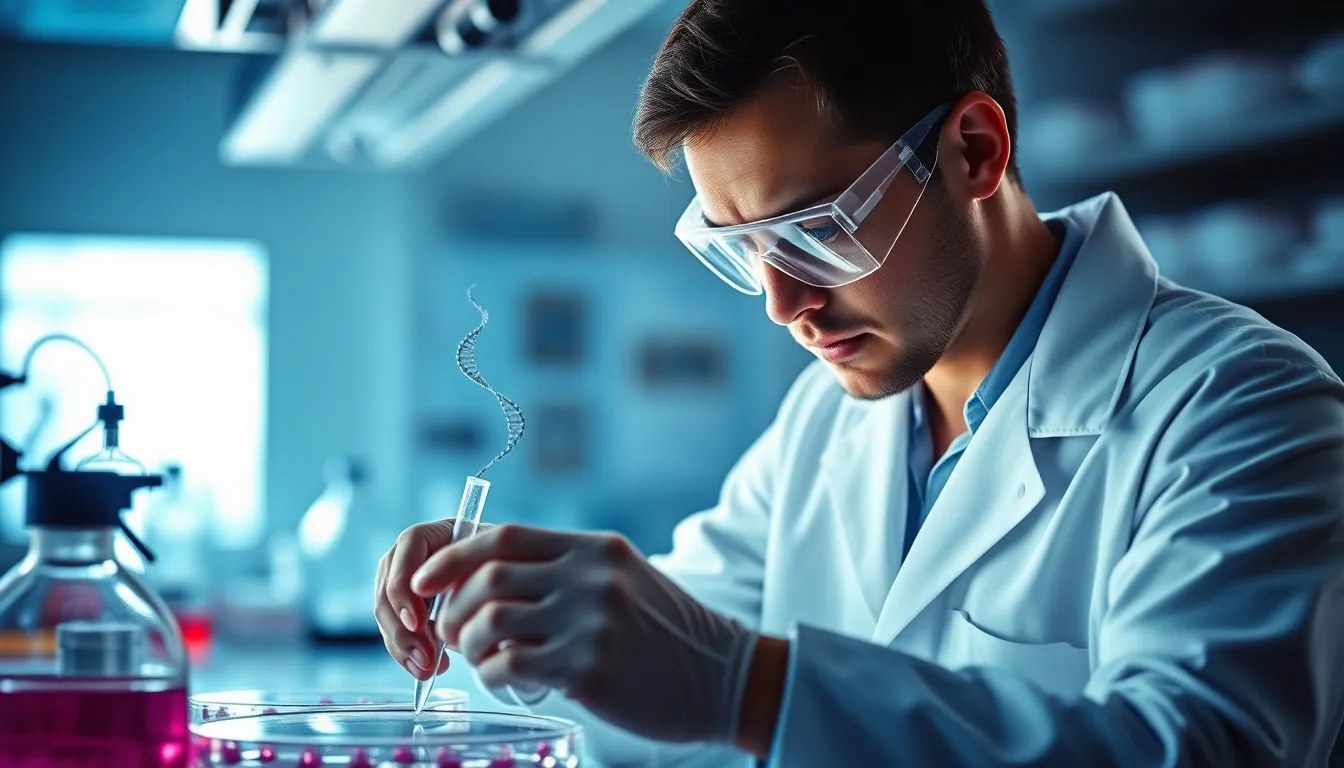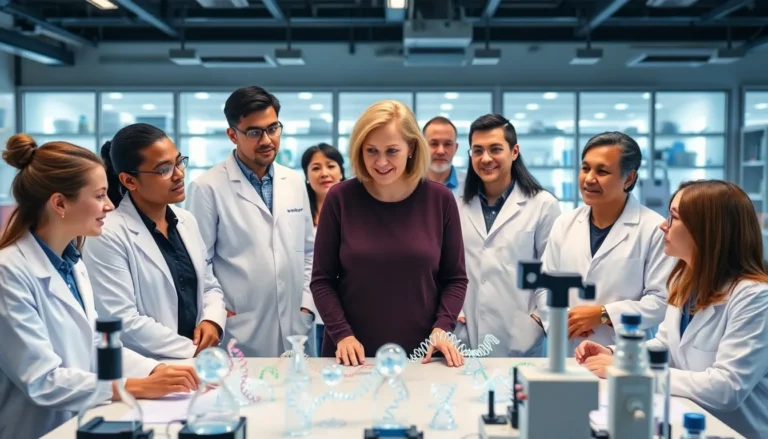Biotech isn’t just a buzzword tossed around in lab coats and safety goggles; it’s a game-changer in the world of science and medicine. Imagine harnessing the power of living organisms to tackle some of humanity’s biggest challenges. From creating life-saving drugs to developing sustainable food sources, biotech is like a superhero for our planet—minus the cape, of course.
But what exactly is biotech? It’s the magical blend of biology and technology that’s transforming industries faster than you can say “petri dish.” Whether it’s genetically modified crops that resist pests or innovative therapies that target diseases at their core, biotech is paving the way for a healthier, more sustainable future. So buckle up as we dive into this fascinating world where science fiction meets reality, and discover how biotech is shaping the landscape of tomorrow.
Table of Contents
ToggleWhat Is Biotech?
Biotechnology stands at the intersection of biology and technology. It encompasses a variety of scientific disciplines, including genetics, microbiology, and bioinformatics. Applications in medicine range from the development of life-saving drugs to innovative therapies that enhance patient care.
Agriculture benefits from biotechnology through the creation of genetically modified organisms (GMOs). These crops exhibit traits such as pest resistance and increased yield, which help meet the growing global food demand.
Environmental aspects of biotech also present compelling advantages. Bioremediation techniques utilize microorganisms to clean up contaminated environments, showcasing biotech’s role in sustainability.
Regenerative medicine exemplifies another frontier for biotechnology. Stem cell research and tissue engineering aim to repair or replace damaged tissues and organs, bringing new hope to patients with chronic conditions.
Advancements in diagnostic technologies further illustrate biotech’s impact. Techniques like CRISPR enable precise gene editing, allowing for early detection and treatment of diseases.
Given its vast potentials, biotechnology represents a key player in addressing some of the world’s most pressing challenges. The integration of biological research with technological innovation fosters a healthier and more sustainable future for all.
Historical Background

Biotechnology has roots that extend back thousands of years. Ancient civilizations utilized fermentation processes for food and drink production, showcasing early applications of biological techniques.
Development of Biotechnology
The formal development of biotechnology began in the mid-20th century when scientists recognized the significance of DNA. In 1953, James Watson and Francis Crick revealed the double helix structure of DNA, prompting further research into genetic manipulation. The 1970s marked a turning point with the advent of recombinant DNA technology, allowing researchers to splice genes from different organisms. This breakthrough laid the groundwork for modern biotechnology, offering new possibilities in medicine and agriculture.
Key Milestones in Biotechnology
Several milestones shaped the biotechnology landscape. In 1973, the first genetically modified organism, a bacterium, emerged from laboratory experiments. By the 1980s, the introduction of the first genetically engineered insulin transformed diabetes treatment. The 1990s ushered in a new era with the completion of the Human Genome Project, which mapped the entire human DNA sequence. More recently, CRISPR technology has enabled precise gene editing, revolutionizing research and therapy. Each milestone highlights biotechnology’s evolving nature and its profound impact on science and society.
Types of Biotechnology
Biotechnology encompasses various specialized fields, each contributing uniquely to society’s needs. These fields include medical, agricultural, and environmental biotechnology, each addressing critical challenges.
Medical Biotechnology
Medical biotechnology focuses on developing innovative therapies and diagnostic tools. It plays a significant role in creating life-saving drugs through recombinant DNA technology. Examples include insulin production and monoclonal antibodies for cancer treatment. Furthermore, gene therapy offers potential cures for genetic disorders. On the diagnostic front, advancements like CRISPR enhance early disease detection and treatment efficacy. This branch of biotechnology continues to evolve, promising improved healthcare outcomes for patients globally.
Agricultural Biotechnology
Agricultural biotechnology aims to enhance crop yield and resilience against pests and diseases. Genetically modified organisms serve as a major highlight in this field. Traits like drought resistance and improved nutritional content are engineered into these crops. Notable examples include Bt corn and Roundup Ready soybeans, which exhibit pest resistance and herbicide tolerance. This technology significantly contributes to food security, addressing challenges posed by climate change and growing populations. Sustainable practices emerge from agricultural biotechnology, enabling farmers to produce more with fewer resources.
Environmental Biotechnology
Environmental biotechnology utilizes biological processes to address ecological problems. Bioremediation stands out as a vital application, employing microorganisms to clean contaminated soils and water. Examples include using bacteria to degrade oil spills or heavy metals. Additionally, waste treatment processes harness biotechnological innovations to recycle organic waste efficiently. This sector supports sustainability efforts, reducing environmental footprints while safeguarding ecosystems. Innovative solutions stem from environmental biotechnology, underscoring its role in promoting a healthier planet.
Applications of Biotechnology
Biotechnology has numerous applications across various sectors, significantly enhancing human life and the environment.
Drug Development
Innovations in drug development stem from biotechnology. Techniques like recombinant DNA technology enable the production of essential therapeutics, such as synthetic insulin and monoclonal antibodies. These advancements address complex diseases like cancer and autoimmune disorders. Companies leverage biotechnological methods for creating vaccines and gene therapies, which offer targeted treatment options. The continuous progress in drug development increases accessibility to life-saving medications, effectively improving patient outcomes.
Genetic Modification
Genetic modification represents a prominent application of biotechnology in agriculture. Scientists engineer crops to express desirable traits, such as pest resistance and drought tolerance. Well-known examples include Bt corn, which reduces pesticide use through built-in pest deterrents. Farmers benefit from genetically modified organisms, as they contribute to higher yields and resource efficiency. Crop varieties developed through genetic modification help mitigate food security challenges, supporting a growing global population.
Bioremediation
Bioremediation employs biological processes to clean up environmental contaminants. Microorganisms, including bacteria and fungi, degrade pollutants in soil and water, making them valuable for environmental restoration efforts. Technologies within bioremediation reduce toxic substances such as heavy metals and petroleum hydrocarbons. This application plays a crucial role in managing industrial waste and restoring ecosystems damaged by human activity. Leveraging natural responses from bacteria and other organisms enhances sustainability while effectively addressing ecological problems.
Ethical Considerations in Biotechnology
Biotechnology raises various ethical considerations that impact its development and application across sectors.
Bioethics and Regulation
Bioethics explores moral implications of biotechnological advances. Regulatory frameworks govern biotechnology to ensure safety and accountability. Agencies like the Food and Drug Administration oversee medical products, ensuring they meet rigorous standards. Ethical concerns arise, especially with genetic editing and GMOs, where potential risks to human health and the environment demand scrutiny. Decisions on patenting biological materials prompt discussions on access and equity. Transparency in research fosters trust and encourages public engagement. Ethical review boards also assess research proposals to uphold ethical standards in experimentation. Ensuring thorough evaluation protects both participants and broader communities.
Public Perception and Acceptance
Public perception significantly influences biotechnology’s acceptance and integration. Misunderstandings may arise from complex scientific concepts, leading to skepticism. Societal views on GMOs, for instance, vary widely, impacting agricultural practices. Media coverage shapes public opinion, often highlighting both benefits and risks. Educational initiatives can bridge knowledge gaps, promoting informed discussion. Communities express differing levels of comfort regarding genetic modifications in foods and medicine. Engaging stakeholders in dialogue builds trust and addresses concerns. Acceptance often hinges on perceived benefits versus risks, making clear communication essential in fostering understanding and solidarity.
Biotechnology stands at the forefront of innovation with its ability to transform health care agriculture and environmental sustainability. As advancements continue to unfold the potential for biotech to address global challenges only grows. From life-saving therapies to sustainable food production and ecological restoration biotechnology is reshaping the world.
Understanding the implications of these technologies alongside ethical considerations is crucial for fostering public trust and acceptance. As society navigates the complexities of biotechnology it’s essential to engage in informed discussions that highlight its benefits while addressing concerns. The future of biotechnology holds promise for a healthier and more sustainable planet for generations to come.




